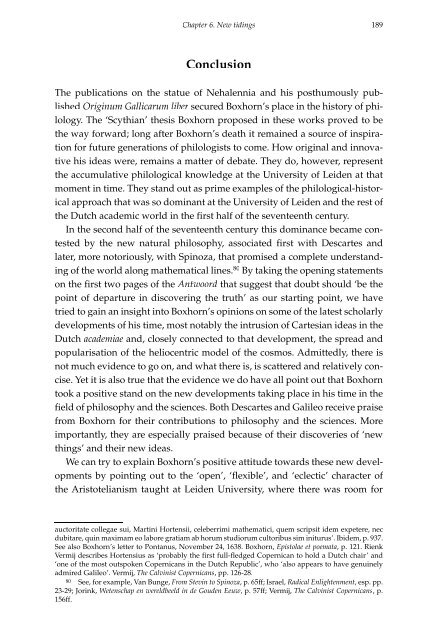historical and political thought in the seventeenth - RePub - Erasmus ...
historical and political thought in the seventeenth - RePub - Erasmus ...
historical and political thought in the seventeenth - RePub - Erasmus ...
You also want an ePaper? Increase the reach of your titles
YUMPU automatically turns print PDFs into web optimized ePapers that Google loves.
Chapter 6. New tid<strong>in</strong>gs<br />
Conclusion<br />
The publications on <strong>the</strong> statue of Nehalennia <strong>and</strong> his posthumously published<br />
Orig<strong>in</strong>um Gallicarum liber secured Boxhorn’s place <strong>in</strong> <strong>the</strong> history of philology.<br />
The ‘Scythian’ <strong>the</strong>sis Boxhorn proposed <strong>in</strong> <strong>the</strong>se works proved to be<br />
<strong>the</strong> way forward; long after Boxhorn’s death it rema<strong>in</strong>ed a source of <strong>in</strong>spiration<br />
for future generations of philologists to come. How orig<strong>in</strong>al <strong>and</strong> <strong>in</strong>novative<br />
his ideas were, rema<strong>in</strong>s a matter of debate. They do, however, represent<br />
<strong>the</strong> accumulative philological knowledge at <strong>the</strong> University of Leiden at that<br />
moment <strong>in</strong> time. They st<strong>and</strong> out as prime examples of <strong>the</strong> philological-<strong>historical</strong><br />
approach that was so dom<strong>in</strong>ant at <strong>the</strong> University of Leiden <strong>and</strong> <strong>the</strong> rest of<br />
<strong>the</strong> Dutch academic world <strong>in</strong> <strong>the</strong> first half of <strong>the</strong> <strong>seventeenth</strong> century.<br />
In <strong>the</strong> second half of <strong>the</strong> <strong>seventeenth</strong> century this dom<strong>in</strong>ance became contested<br />
by <strong>the</strong> new natural philosophy, associated first with Descartes <strong>and</strong><br />
later, more notoriously, with Sp<strong>in</strong>oza, that promised a complete underst<strong>and</strong><strong>in</strong>g<br />
of <strong>the</strong> world along ma<strong>the</strong>matical l<strong>in</strong>es. 80 By tak<strong>in</strong>g <strong>the</strong> open<strong>in</strong>g statements<br />
on <strong>the</strong> first two pages of <strong>the</strong> Antwoord that suggest that doubt should ‘be <strong>the</strong><br />
po<strong>in</strong>t of departure <strong>in</strong> discover<strong>in</strong>g <strong>the</strong> truth’ as our start<strong>in</strong>g po<strong>in</strong>t, we have<br />
tried to ga<strong>in</strong> an <strong>in</strong>sight <strong>in</strong>to Boxhorn’s op<strong>in</strong>ions on some of <strong>the</strong> latest scholarly<br />
developments of his time, most notably <strong>the</strong> <strong>in</strong>trusion of Cartesian ideas <strong>in</strong> <strong>the</strong><br />
Dutch academiae <strong>and</strong>, closely connected to that development, <strong>the</strong> spread <strong>and</strong><br />
popularisation of <strong>the</strong> heliocentric model of <strong>the</strong> cosmos. Admittedly, <strong>the</strong>re is<br />
not much evidence to go on, <strong>and</strong> what <strong>the</strong>re is, is scattered <strong>and</strong> relatively concise.<br />
Yet it is also true that <strong>the</strong> evidence we do have all po<strong>in</strong>t out that Boxhorn<br />
took a positive st<strong>and</strong> on <strong>the</strong> new developments tak<strong>in</strong>g place <strong>in</strong> his time <strong>in</strong> <strong>the</strong><br />
field of philosophy <strong>and</strong> <strong>the</strong> sciences. Both Descartes <strong>and</strong> Galileo receive praise<br />
from Boxhorn for <strong>the</strong>ir contributions to philosophy <strong>and</strong> <strong>the</strong> sciences. More<br />
importantly, <strong>the</strong>y are especially praised because of <strong>the</strong>ir discoveries of ‘new<br />
th<strong>in</strong>gs’ <strong>and</strong> <strong>the</strong>ir new ideas.<br />
We can try to expla<strong>in</strong> Boxhorn’s positive attitude towards <strong>the</strong>se new developments<br />
by po<strong>in</strong>t<strong>in</strong>g out to <strong>the</strong> ‘open’, ‘flexible’, <strong>and</strong> ‘eclectic’ character of<br />
<strong>the</strong> Aristotelianism taught at Leiden University, where <strong>the</strong>re was room for<br />
auctoritate collegae sui, Mart<strong>in</strong>i Hortensii, celeberrimi ma<strong>the</strong>matici, quem scripsit idem expetere, nec<br />
dubitare, qu<strong>in</strong> maximam eo labore gratiam ab horum studiorum cultoribus sim <strong>in</strong>iturus’. Ibidem, p. 937.<br />
See also Boxhorn’s letter to Pontanus, November 24, 1638. Boxhorn, Epistolae et poemata, p. 121. Rienk<br />
Vermij describes Hortensius as ‘probably <strong>the</strong> first full-fledged Copernican to hold a Dutch chair’ <strong>and</strong><br />
‘one of <strong>the</strong> most outspoken Copernicans <strong>in</strong> <strong>the</strong> Dutch Republic’, who ‘also appears to have genu<strong>in</strong>ely<br />
admired Galileo’. Vermij, The Calv<strong>in</strong>ist Copernicans, pp. 126-28.<br />
80 See, for example, Van Bunge, From Stev<strong>in</strong> to Sp<strong>in</strong>oza, p. 65ff; Israel, Radical Enlightenment, esp. pp.<br />
23-29; Jor<strong>in</strong>k, Wetenschap en wereldbeeld <strong>in</strong> de Gouden Eeuw, p. 57ff; Vermij, The Calv<strong>in</strong>ist Copernicans, p.<br />
156ff.<br />
189

















